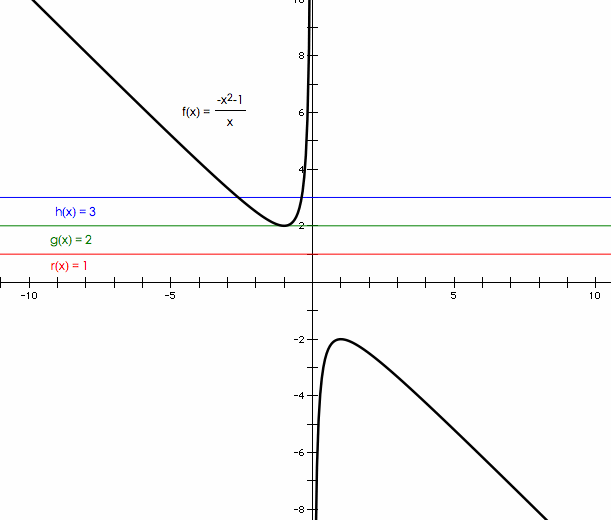

Assignment 3:
Exploring the XB plane
by
Margo Gonterman
Below is the graph of the equation ![]() in the XB plane. This means that the x-axis is horizontal as usual but instead of having y being the vertical axis, the values on the vertical axis represent values of b.
in the XB plane. This means that the x-axis is horizontal as usual but instead of having y being the vertical axis, the values on the vertical axis represent values of b.
Solving for b yields  or
or ![]() .
.
The graph has a vertical asymptote at x=0 and a slant asymptote at b=-x.

To determine the number of real solutions for a given value of b, find the number of intersections with the horizontal line at that value of b.
Below is an animation as b varies between-5 and 5.
Note that there appears to be two real solutions (or intersections) when x>2 or x<-2.
There appears to be one real solution when x=1 or x=-1.
There appear to be no real solutions when -2<x<2.

We can use the discriminant, ![]() to determine the number of real solutions.
to determine the number of real solutions.
In our example equation, a=1 and c=1.
To determine where there is one real solution, we want to find where the discriminant equals zero. There are no real solutions when the discriminant is less than zero. There are two real solutions when the discriminant is greater than zero.
Our equation has one real solution when:
We can use calculus to check this answer by taking the derivative and finding the maximum and minimum of the graph. The method for solving using calculus is demonstrated below.
The solution below is in terms of x. Simply plug it into the equation that is solved for b to determine the corresponding b values.
The points where there is only one real solution occur at (-1,2) and (1,-2) where the points are (x,b).
1. Start by solving for y. 2. Subtract x^2 and 1 from both sides. 3. Divide both sides by x 4. Divide both terms by x to simplify. 5. Rewrite 1/x as x^-1 6. Take the derivative. 7. Set the derivative equal to zero. 8. Solve for x. 9. Add 1 to both sides. 10. Multiply both sides by x^2 11. Take the square root of both sides. (Don't forget the +/-!!) |
 |
General Solution
In general, for any quadratic equation is standard form, it is possible to determine where there is only one real solution using the method that follows:
First, start by solving the discriminant for b.

Then plug b into the general form of the quadratic.
Then factor and solve for x.

Thus, when
there is only one real solution to quadratic equation.